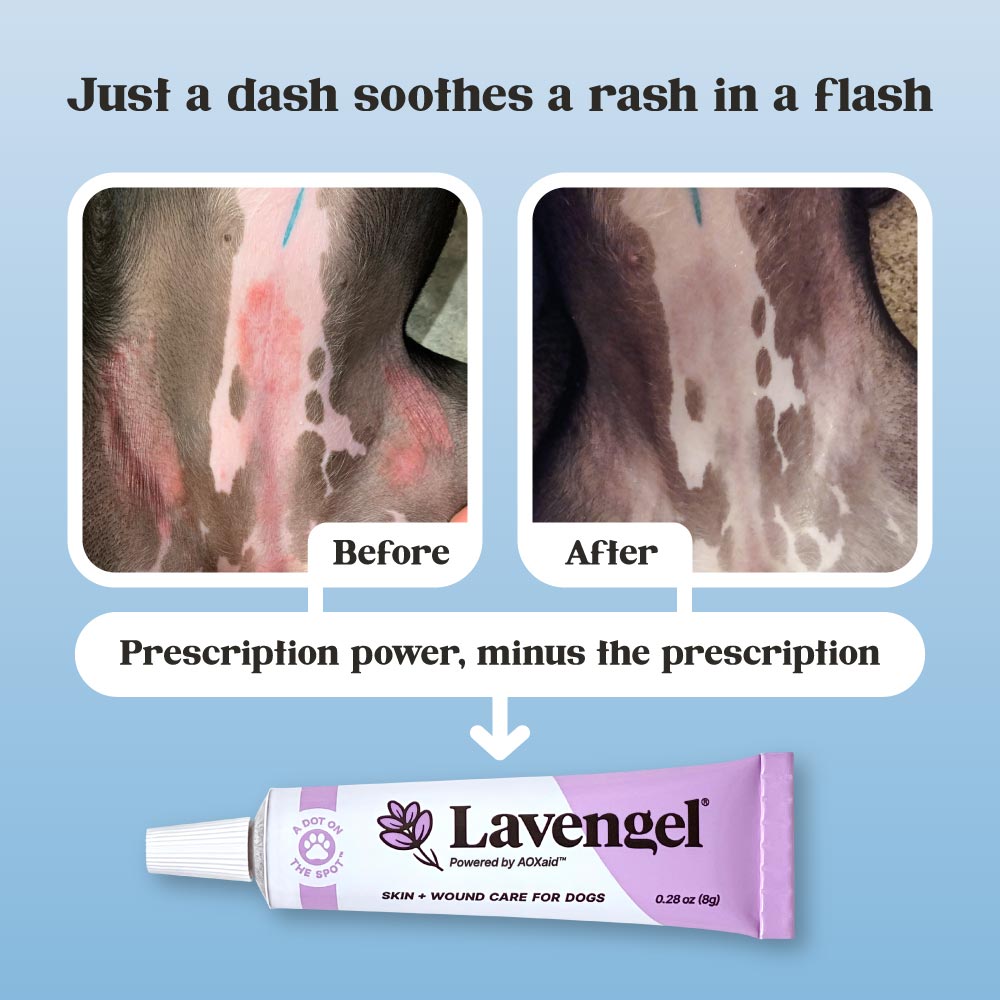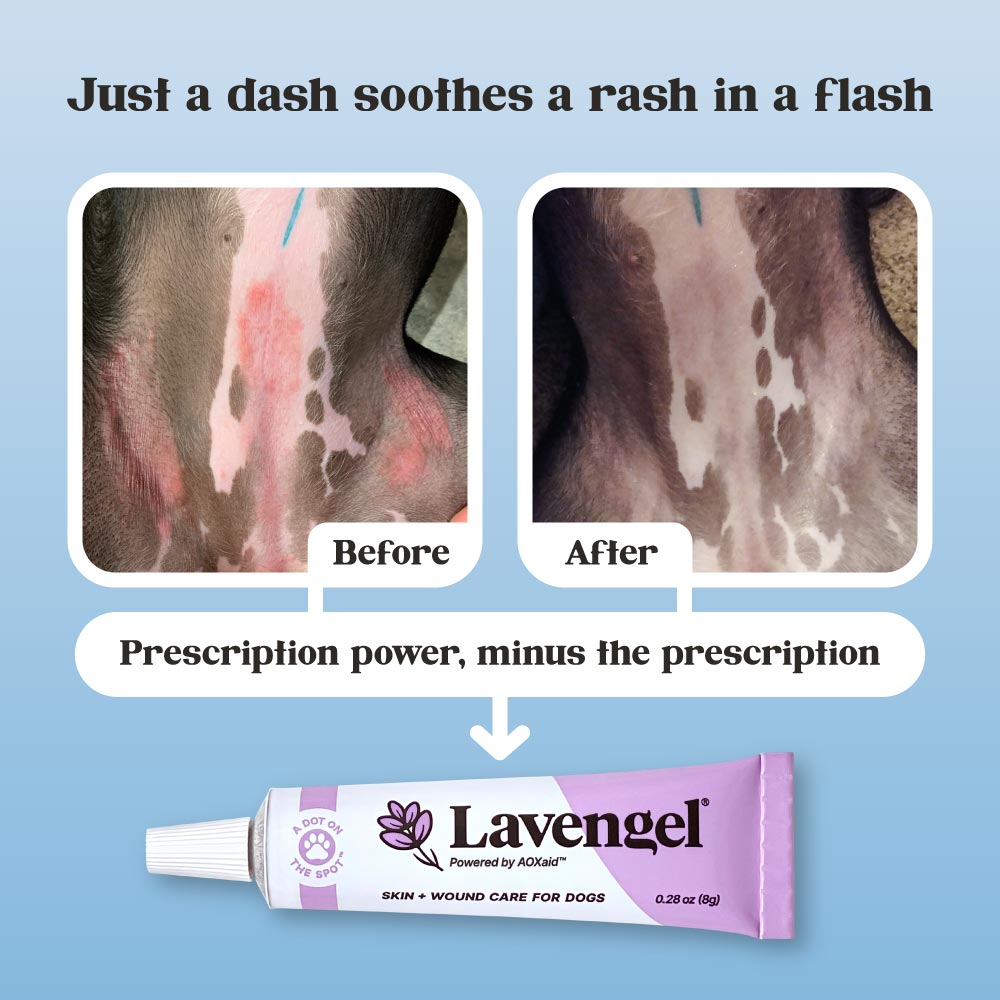Hey there, fellow dog lovers! If you're like me, always keeping a close eye on your furry friend's health, you might have noticed some skin issues from time to time.
Dogs can get itchy, scratchy, and downright uncomfortable because of something called dermatitis. Dermatitis, simply put, is an inflammation of the skin, which can lead to redness, itching, and sometimes even infections.
Today, we're diving into three common types of dermatitis in dogs:
- Atopic Dermatitis
- Flea Allergy Dermatitis
- Acute Moist Dermatitis (also known as hot spots)
Understanding the differences can help us identify and provide the adequate form of care that will help get our barkers back to normal.

Atopic dermatitis on a pitbull's inner hips and belly, likely due to skin allergies; via r/Alarmed_Newt4258 on Reddit.
Atopic Dermatitis
Atopic dermatitis, also referred to as atopy, eczema, or allergy dermatitis, is a chronic skin condition triggered by environmental allergens like pollen, dust mites, or mold, or by food allergies. It's much like that annoying seasonal allergy we humans get (e.g., eczema), but for dogs.
Atopy is quite common in dogs. You'll often see dogs with atopic dermatitis scratching a lot, especially around their face, ears, feet, belly, and underarms. It tends to flare up during certain times of the year when allergens are more prevalent.
Key Characteristics of Atopic Dermatitis
- Itchy skin, especially around the face, feet, underarms, and belly.
- Recurrent ear infections or redness.
- Excessive licking and chewing of the paws.

Atopic dermatitis on belly and underarms, via r/AlternativeAd7703 on Reddit.
Flea Allergy Dermatitis (FAD)
This one is pretty straightforward. Flea allergy dermatitis is an allergic reaction to flea saliva. A single flea bite can cause your dog to go into a scratching frenzy, particularly around areas that fleas seek to hide, such as the ears, armpits, hips, back, under the collar, skin folds, and the base of the tail.
If you spot flea dirt (tiny black or brown specks that are actually digested blood), it's a good indicator that fleas are involved. On a larger scale, you might notice hair loss, hot spots, or infections due to bacteria (pyoderma) or yeast (Malassezia) that develop due to all the scratching and damage to the skin.
Key Characteristics of Flea Allergy Dermatitis
- Severe itching, primarily around the base of the tail, neck, and back.
- Hair loss and hot spots, which are areas of inflamed, moist, and irritated skin.
- Presence of fleas or flea dirt on the dog's coat.

Flea Allergy Dermatitis (FAD) infographic from White Horse Vet.
Acute Moist Dermatitis
Acute moist dermatitis, or hot spots, are those sudden, nasty-looking red patches that can appear on your dog out of nowhere. Hot spots result from trauma caused by the dog scratching, licking, or chewing at a particular area, causing a moist, inflamed lesion. It's not a stretch to say that hot spots can develop due to, or along with, another form of dermatitis.
Hot spots are most commonly found on the head, neck, hips, chest, groin, and base of the tail, and they can become quite painful if not treated quickly.
Key Characteristics of Acute Moist Dermatitis
- Red, raw, and moist lesions, often accompanied by a foul odor.
- Typically found on the head, hips, groin, and chest.
- Hair loss around the lesion is common.
- Lesions spread and worsen as a dog licks them; infections are common.

Acute moist dermatitis (hot spot) on rescue dog's back. Read more about Samson's journey.
Spotting the Differences Between These Types of Dermatitis
While all three conditions involve itching and skin irritation, the key differences lie in their causes and specific manifestations. It is also possible for a dog to have more than one type of dermatitis at a time.
Atopic dermatitis is linked to environmental or food allergens; flea allergy dermatitis is caused by an allergic reaction to flea bites; and acute moist dermatitis results from localized trauma in response to an irritation.
How to Spot These Differences
- Atopic Dermatitis: Look for symptoms in areas that come into contact with allergens, such as the face, ears, belly and feet. It's often seasonal.
- Flea Allergy Dermatitis: Check for fleas or flea dirt, and focus on the dog's reaction around the back and base of the tail.
- Acute Moist Dermatitis: Notice the sudden onset of red, oozing spots that your dog may be aggressively licking or biting.

Before and after comparison of hot spot with black scabbing on a dog's belly after 5 days of treatment with Lavengel®.
How Lavengel® Can Help With Dog Dermatitis
Now, let's talk about how to soothe these irritations. Lavengel® is a fantastic natural skin and wound care gel that's perfect for these issues. It's packed with healing ingredients, including Vitamin E TPGS.
This special form of Vitamin E is water-soluble, which means it helps the active ingredients in Lavengel® absorb into your dog's skin more quickly and effectively than regular Vitamin E. This rapid absorption can provide faster relief from itching and inflammation, making it a great option for managing dermatitis.
Lavengel® works wonders in soothing the itch to prevent further skin damage, protecting the skin from microbes that cause infection, and promoting the regeneration of the skin and fur.

Healing progression of hot spot on groin of husky after 2 weeks of Lavengel®.
Taking care of your dog's skin is crucial for their comfort and health - and your sanity. With the right knowledge and some Lavengel®, you can keep your pupper's skin in top shape.
Resources on Dermatitis, Rashes, and Other Dog Skin Issues
For more information on acute moist dermatitis:
For more information on atopic dermatitis and otitis (ear infections) in dogs:
For 11 common forms of canine dermatitis (including these 3, with photos), as well as various canine skin problems:








